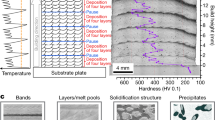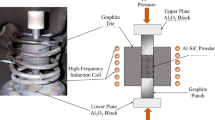Abstract
Mechanical milling is an effective technique for the preparation of fine metallic and ceramic powders and can also be used to drive a wide range of chemical reactions. Milling devices include planetary machines, attritors and vibrational mills; products include amorphous, nanocrystalline and quasicrystalline materials, supersaturated solid solutions, reduced minerals, high-surface-area catalysts and reactive chemicals1,2,3. During milling, solid–solid, solid–liquid and solid–gas reactions are initiated through repeated deformation and fracture of powder particles. A separate materials synthesis and processing technique involves reacting a material in a gas atmosphere under an electrical discharge4,5,6,7. Here we show that the application of low-current, high-voltage electrical impulses during milling can result in both faster reactions and new synthesis and processing routes. We demonstrate the effects of glow (cold) and spark (hot) discharge milling on particle fracture for brittle, low-conductivity materials and ductile metals. Glow discharge milling was found to promote solid–gas reactions whereas spark discharge milling promotes fast fracturing, recrystallization, mineral reduction and solid–solid reactions.
This is a preview of subscription content, access via your institution
Access options
Subscribe to this journal
Receive 51 print issues and online access
$199.00 per year
only $3.90 per issue
Buy this article
- Purchase on Springer Link
- Instant access to full article PDF
Prices may be subject to local taxes which are calculated during checkout





Similar content being viewed by others
References
Zoz, H. Attritor technology—latest developments. Mater. Sci. Forum 179–181, 419–424 (1995)
Koch, C. C. Materials synthesis by mechanical alloying. Annu. Rev. Mater. Sci. 18, 121–143 (1989)
Basset, D., Matteazzi, P. & Mani, F. Designing a high energy ball-mill for synthesis nanophase materials in large quantities. Mater. Sci. Eng. A A168, 149–152 (1993)
Pelletier, J. et al. New trends in DECR plasma technology: applications to novel duplex treatments and process combinations with extreme plasma specifications. Surf. Coat. Technol. 139, 222–232 (2001)
Takaki, K., Taguchi, D. & Fujiwara, T. Voltage–current characteristics of high-current glow discharges. Appl. Phys Lett. 78, 2646–2648 (2001)
Mishra, R. S. & Mukherjee, A. K. Electric pulse assisted rapid consolidation of ultrafine grained alumina matrix composites. Mater. Sci. Eng. A A287, 178–182 (2000)
El-Eskandarany, M. S., Sumijama, K., Aoki, K. & Suzuki, K. Syntheses of full-density nanocrystalline titanium nitride compacts by plasma-activated sintering of mechanically reacted powder. Met. Mater. Trans. A 29A, 1973–1981 (1998)
Calka, A. & Radlinski, A. P. Universal high performance ball milling device and its application for mechanical alloying. Mater. Sci. Eng. A134, 1350–1353 (1991)
Wexler, D., Calka, A. & Colburn, S. J. Rapid sintering of nanostructural powder to form Si3N4 . Mater. Sci. Forum 269–272, 219–224 (1998)
Li, Z. L., Williams, J. S. & Calka, A. The role of hydrogen and iron in silicon nitridation by ball milling. J. Appl. Phys. 81, 8028–8034 (1997)
Acknowledgements
We acknowledge R. deJong, R. Kinnell and S. Selby for their contributions towards construction of the discharge milling devices. We are especially grateful to D. Dunne for his support and leadership. This project was supported by funding from the Australian Research Council.
Author information
Authors and Affiliations
Corresponding author
Ethics declarations
Competing interests
The authors declare that they have no competing financial interests.
Rights and permissions
About this article
Cite this article
Calka, A., Wexler, D. Mechanical milling assisted by electrical discharge. Nature 419, 147–151 (2002). https://doi.org/10.1038/nature00985
Received:
Accepted:
Issue Date:
DOI: https://doi.org/10.1038/nature00985
This article is cited by
-
Electroplasticity effects: from mechanism to application
The International Journal of Advanced Manufacturing Technology (2024)
-
Multicatalytic dye degradation capability of Ba2NaNb5O15 ferroelectric ceramics
Proceedings of the Indian National Science Academy (2023)
-
Advancing mechanochemical synthesis by combining milling with different energy sources
Nature Reviews Chemistry (2022)
-
Modelling and experimental investigation of flat surface achieved by large rectangular electrochemical jet milling
The International Journal of Advanced Manufacturing Technology (2022)
-
Direct synthesis of AlN nano powder by dielectric barrier discharge plasma assisted high-energy ball milling
Journal of Materials Science: Materials in Electronics (2016)
Comments
By submitting a comment you agree to abide by our Terms and Community Guidelines. If you find something abusive or that does not comply with our terms or guidelines please flag it as inappropriate.



